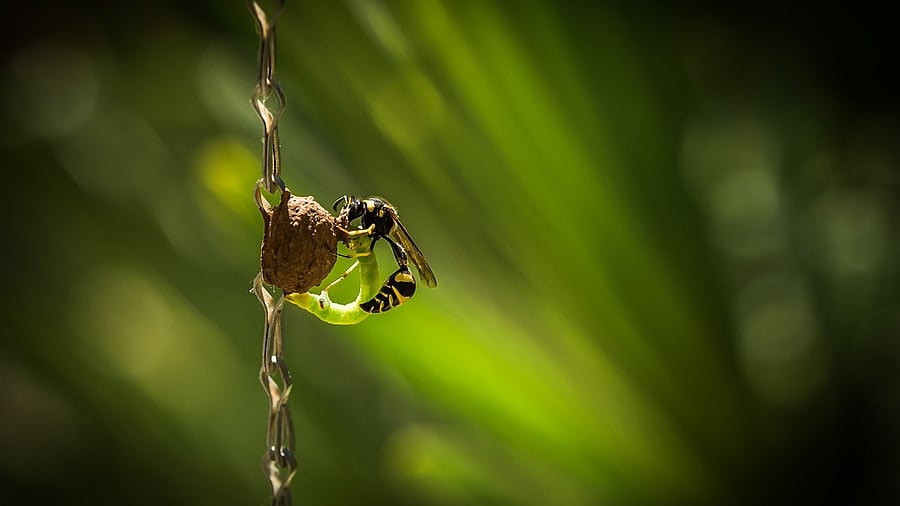
Potter wasps or mason wasps.
Credit: Pixabay
We have a metal mesh installed on the windows of our cottage at Navilu Kaadu. The contraption, however, has failed to keep rats and field mice from breaking in. The pertinacious rodents chewed holes through the mesh on our bathroom windows, creating a freeway not just for themselves, but for geckos, garden lizards, beetles, wasps and other creatures seeking a safe house.
One of these resourceful critters settled in our bathroom, for a nursery — the potter wasp. She went on to stick tiny mud pots in the corners of the ceiling as nests for her progeny.
All potter wasp species belong to the subfamily Eumeninae and make up a majority — about 3794 species worldwide and 189 species in India (Pannure et al. 2016; Tan et al. 2018) — of the nearly 5000 species of social and solitary wasps that fall under the family Vespidae and order Hymenoptera. Unlike the social paper wasps that live in colonies, potter wasps, called Eumenid wasps, are solitary creatures. Unlike their tetchy social cousins that are quick to attack perceived intruders, potter wasps are even-keeled and rarely sting.
Potter wasps, also mason wasps, are a little under an inch long and are adorned with striking black and saffron, tangerine or auburn markings. They look like flying dumbbells, with a slender waist called ‘petiole’ connecting their prominent thorax and abdomen. A pair of club-shaped wings fold along the length of their body when in repose. Adult potter wasps feed on nectar and pollinate flowering plants in the process, while their young are carnivorous.
Newly minted adults mate soon after leaving their nests. The males have no role beyond fertilising the females. Mated females get busy with nesting duties.
The female potter wasp brings an artist’s flourish to nest-building, shaping perfect little pots complete with a lip from mud and saliva, no doubt inspiring the earliest human potters. Potter wasps or Eumenids aren’t picky about nest real estate and forge their gooseberry-sized nests on plants, trees, walls or any place safe for their young to mature undisturbed. Some Eumenids choose to refurbish holes in tree snags, the ground, roof structures or even older nest cells. As a single mum, the female potter wasp demonstrates remarkable parenting prowess, though her methods are reminiscent of sci-fi horror flicks!
After she is done crafting the nest, the potter wasp lays a single, cylindrical egg suspended with a strand just inside the mouth of the nest with her ovipositor. She then hunts down ill-fated caterpillars and insect larvae, injects them with venom to paralyse them partially, and stashes up to twelve live prey in a single nest. In some potter wasp species, the female lays the egg directly on the paralysed prey inside the nest. The potter mum’s involvement ends with finally plugging the mouth of the nest with mud, leaving her baby to grow within. She may go on to build more nests and lay eggs.
The egg hatches in less than a week, and the larva proceeds to fatten on the reserve of fresh, succulent grubs before pupating. Eventually, the fully-developed imago or adult chomps through the nest and gets on with the mission of keeping the wheel of life spinning.
The Eumenid wasp goes from egg to imago in about 20 to 30 days. Potter wasps are parasitoids. The young of parasitoid wasps develop on or inside a live host species, eventually killing it. Despite the wasp mum’s exacting precautions, the tables sometimes turn, and her well-stocked nest ends up as fair game for other parasitoid wasp and fly species.
The opportunistic invaders deposit their eggs on the exterior wall of the potter wasp’s nest or inside the nest in stealth when the potter mum is out gathering prey. The interloping larvae either burrow through the wall of the nest upon hatching or hatch inside the nest cell and devour the food reserve and the potter wasp larva.
Studies have shown that potter wasps are exceptional biological pest control agents. They prey on agricultural pests, including several species of moth larvae that decimate legume crops and fruit and vegetable-bearing plants. (Udayakumar et al., 2022)
As for the potter wasp nests in our bathroom at Navilu Kaadu, we’ve signed off our privacy in exchange for pest extermination services!
Rooting for Nature is a monthly column on an off-kilter urban family’s trysts with nature on a natural farm.
The author runs Green Goobé, a sustainable venture committed to a greener, cleaner planet. She posts as @ramyacoushik on Instagram. Reach her at bluejaydiaries@gmail.com